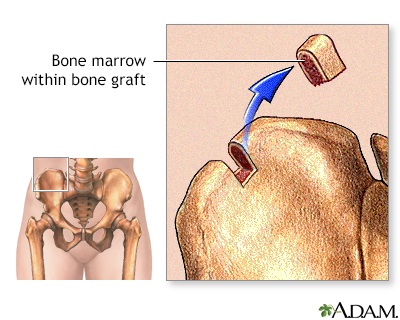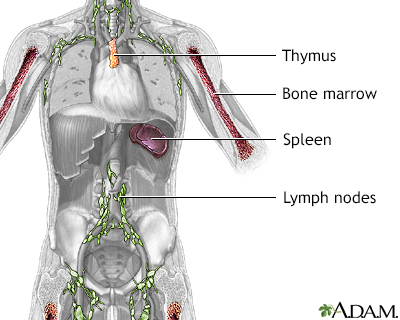Pregnancy SmartSiteTM
ALL; Acute lymphoblastic leukemia; Acute lymphoid leukemia; Acute childhood leukemia; Cancer - acute childhood leukemia (ALL); Leukemia - acute childhood (ALL); Acute lymphocytic leukemia DefinitionAcute lymphoblastic leukemia (ALL) is a fast-growing cancer of a type of white blood cells called lymphocytes. ALL occurs when the bone marrow produces a large number of immature lymphoblasts, a cancerous form of lymphocytes. Bone marrow is the soft, spongy tissue found inside most bones in children and in the front chest bone (sternum) and the pelvis bones in adults that helps form all blood cells. The abnormal lymphoblasts grow quickly and replace normal cells in the bone marrow. ALL prevents healthy blood cells from being made. Life-threatening symptoms can occur as normal blood counts drop. CausesMost of the time, no clear cause can be found for ALL. The following factors may play a role in the development of all types of leukemia:
The following factors are known to increase the risk for ALL:
This type of leukemia usually affects children ages 3 to 7. ALL is the most common childhood cancer, but it can also occur in adults. SymptomsALL makes a person more likely to bleed and develop infections. Symptoms include:
These symptoms can occur with other conditions. Talk to your health care provider about the meaning of specific symptoms. Exams and TestsYour provider will perform a physical exam and ask about your symptoms. Blood tests may include:
Tests are also done to look for changes in the DNA inside the abnormal white cells. Certain DNA changes may determine how well a person does (prognosis), and what kind of treatment is recommended. TreatmentThe first goal of treatment is to get blood counts back to normal. If this occurs and the bone marrow looks healthy under the microscope, the cancer is said to be in remission. Chemotherapy is the first treatment tried with the goal of achieving a remission.
After a remission is achieved, more treatment is given to achieve a cure. This treatment can include more IV chemotherapy or radiation to the brain. Stem cell or bone marrow transplant from another person may also be done. Further treatment depends on:
You and your provider may need to manage other concerns during your leukemia treatment, including:
Support GroupsYou can ease the stress of illness by joining a cancer support group. Sharing with others who have common experiences and problems can help you not feel alone. Outlook (Prognosis)Those who respond to treatment right away tend to do better. Most children with ALL can be cured. Children often have a better outcome than adults. Possible ComplicationsBoth leukemia itself and the treatment can lead to many problems such as bleeding, weight loss, and infections. When to Contact a Medical ProfessionalContact your provider if you or your child develops symptoms of ALL. PreventionThe risk for developing ALL may be reduced by avoiding contact with certain toxins, radiation, and chemicals. ReferencesNational Cancer Institute website. Acute lymphoblastic leukemia treatment (PDQ) - health professional version. www.cancer.gov/types/leukemia/hp/adult-all-treatment-pdq. Updated March 28, 2024. Accessed August 2, 2024. National Cancer Institute website. Childhood acute lymphoblastic leukemia treatment (PDQ) - health professional version. www.cancer.gov/types/leukemia/hp/child-all-treatment-pdq. Updated June 18, 2024. Accessed August 2, 2024. Pillai PM, Carroll WL. Acute lymphoblastic leukemia. In: Fish JD, Lipton JM, Lanzkowsky P, eds. Lanzkowsky's Manual of Pediatric Hematology and Oncology. 7th ed. Philadelphia, PA: Elsevier; 2022:chap 18. | |
| |
Review Date: 2/2/2023 Reviewed By: Mark Levin, MD, Hematologist and Oncologist, Monsey, NY. Review provided by VeriMed Healthcare Network. Internal review and update on 02/20/2024 by David C. Dugdale, MD, Medical Director, Brenda Conaway, Editorial Director, and the A.D.A.M. Editorial team. The information provided herein should not be used during any medical emergency or for the diagnosis or treatment of any medical condition. A licensed medical professional should be consulted for diagnosis and treatment of any and all medical conditions. Links to other sites are provided for information only -- they do not constitute endorsements of those other sites. No warranty of any kind, either expressed or implied, is made as to the accuracy, reliability, timeliness, or correctness of any translations made by a third-party service of the information provided herein into any other language. © 1997- A.D.A.M., a business unit of Ebix, Inc. Any duplication or distribution of the information contained herein is strictly prohibited. | |

 Bone marrow aspira...
Bone marrow aspira... Acute lymphocytic ...
Acute lymphocytic ... Auer rods
Auer rods Bone marrow from h...
Bone marrow from h... Immune system stru...
Immune system stru...
